Discover 11 hidden attractions, cool sights, and unusual things to do in Auburn (United States). Don't miss out on these must-see attractions: Willard Memorial Chapel, Fort Hill Cemetery, and Harriet Tubman National Historical Park. Also, be sure to include Dr. Sylvester Willard Mansion in your itinerary.
Below, you can find the list of the most amazing places you should visit in Auburn (New York).
Table of Contents
Willard Memorial Chapel

Building in Auburn, New York. The Willard Memorial Chapel and the adjoining Welch Memorial Hall are historic conjoined buildings located at 17-19 Nelson Street in Auburn, Cayuga County, New York. Built 1892-94 for the Auburn Theological Seminary, the buildings contain the only surviving ecclesiastical installation of stained glass and interior decoration by Louis Comfort Tiffany that is still in its original setting. They were declared a National Historic Landmark in 2005.[1]
Address: 17 Nelson St, 13021-2668 Auburn
Fort Hill Cemetery
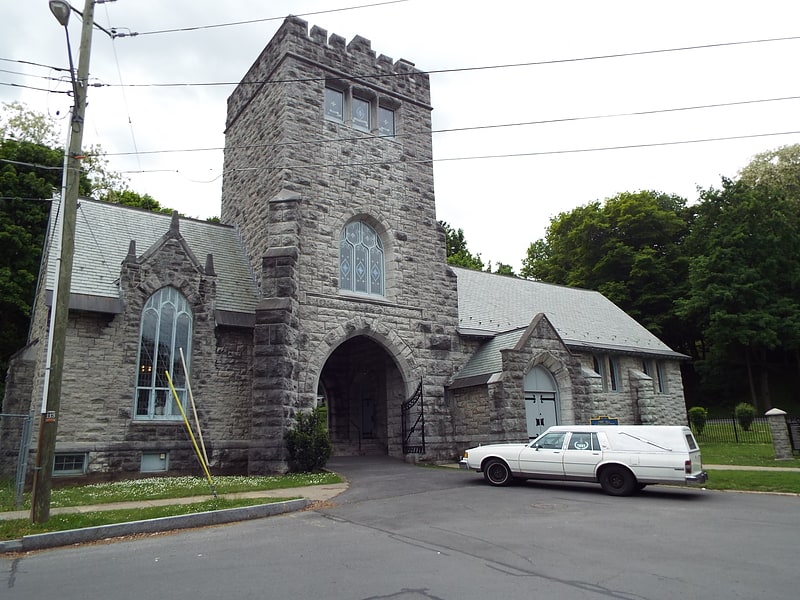
Cemetery in Auburn, New York. Fort Hill Cemetery is a historically significant cemetery located in Auburn, New York. It was incorporated on May 15, 1851 under its official name: "Trustees of the Fort Hill Cemetery Association of Auburn". It is known for its headstones of notable people such as former Secretary of State William H. Seward, his son, William H. Seward Jr. and abolitionist and freedom fighter Harriet Tubman.[2]
Address: 19 Fort St, 13021-3733 Auburn
Harriet Tubman National Historical Park
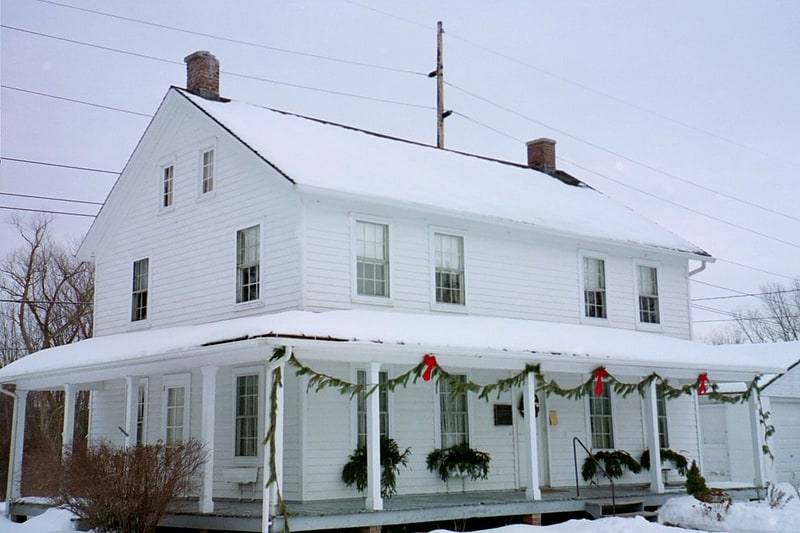
Harriet Tubman National Historical Park is a US historical park in Auburn and Fleming, New York, associated with the life of Harriet Tubman. It comprises three properties: the Harriet Tubman Home for the Aged, in Auburn; the nearby Harriet Tubman Residence; and the Thompson A.M.E. Zion Church in Auburn. They are located at 180 and 182 South Street, and 90 Franklin Street, respectively. The Zion Church unit is administered by the National Park Service, while the South Street properties, including a historic barn and a visitor center, are jointly managed and operated by both the NPS and the Harriet Tubman Home, Inc. The church also works with the NPS in park operations. The Harriet Tubman Grave in nearby Fort Hill Cemetery is not part of the park.
The group of properties also makes up a National Historic Landmark, the first parcel having been declared in 1974, with two others added in 2001.
Tubman was a major conductor on the Underground Railroad, and known as "the Moses of her people". She moved to Auburn with her parents after spending eight to ten years in St. Catharines, Ontario. She continued working as a suffragist, and worked all her life to care for others who were unable to care for themselves.
The Harriet Tubman Home for the Aged is the house where she fulfilled her dream of opening a home for indigent and elderly African-Americans. In 1911 she was admitted there, herself, and remained there until her death in 1913.
The Harriet Tubman Residence was Tubman's home during much of the time she lived in Auburn, from 1859 through 1913. The land was sold to her in 1859 by then-Senator William H. Seward.
Thompson A.M.E. Zion Church is an African Methodist Episcopal Zion Church where Harriet Tubman attended services. Later in her life, she deeded the Home for the Aged to the church, for it to manage after her death.[3]
Address: 180 S Street Rd, 13021-5636 Auburn
Dr. Sylvester Willard Mansion
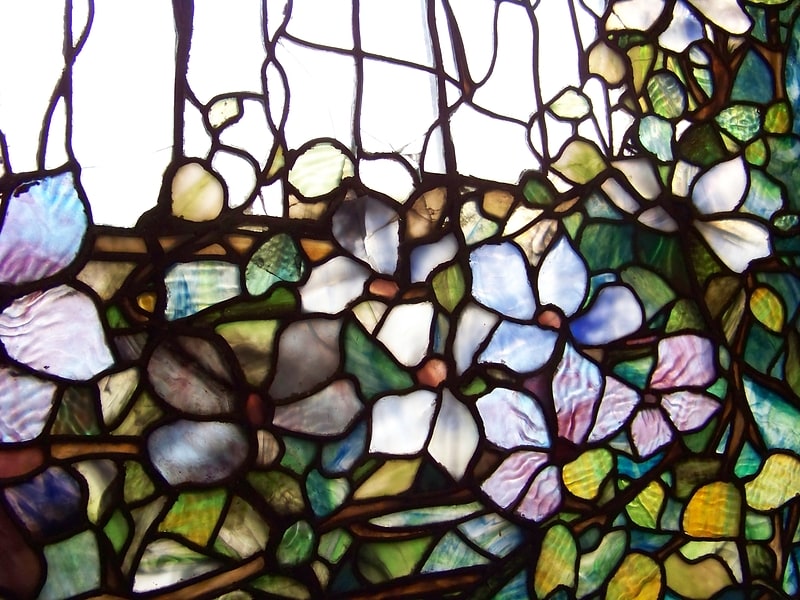
Mansion. Dr. Sylvester Willard Mansion, also known as the Cayuga Museum of History and Art, is a historic mansion and related outbuildings located in Auburn, Cayuga County, New York state.[4]
William H. Seward House
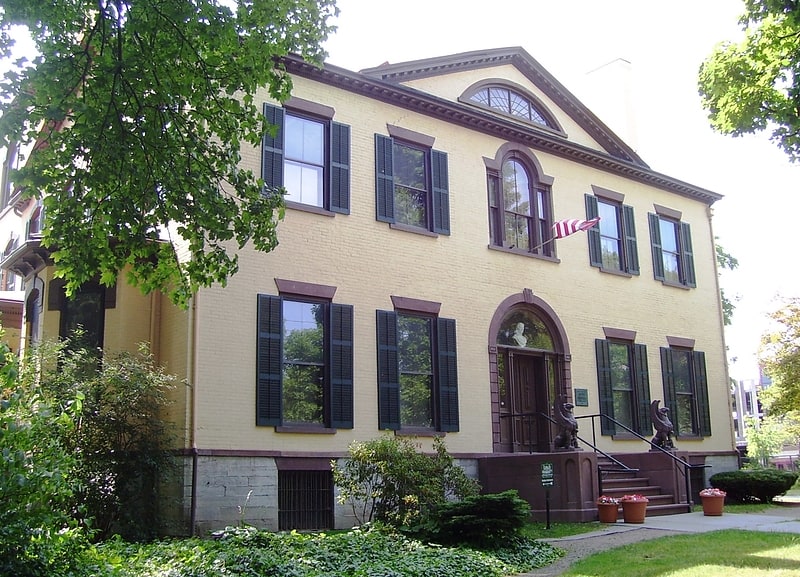
The William H. Seward House Museum is a historic house museum at 33 South Street in Auburn, New York. Built about 1816, the home of William H. Seward, who served as a New York state senator, the governor of New York, a U.S. senator, a presidential candidate, and then Secretary of State under presidents Abraham Lincoln and Andrew Johnson. The house was declared a National Historic Landmark in 1964, and added to the National Register of Historic Places on October 15, 1966. It is now maintained by nonprofit organization as a museum dedicated to Seward's legacy.[5]
St. Peter's Episcopal Church Complex
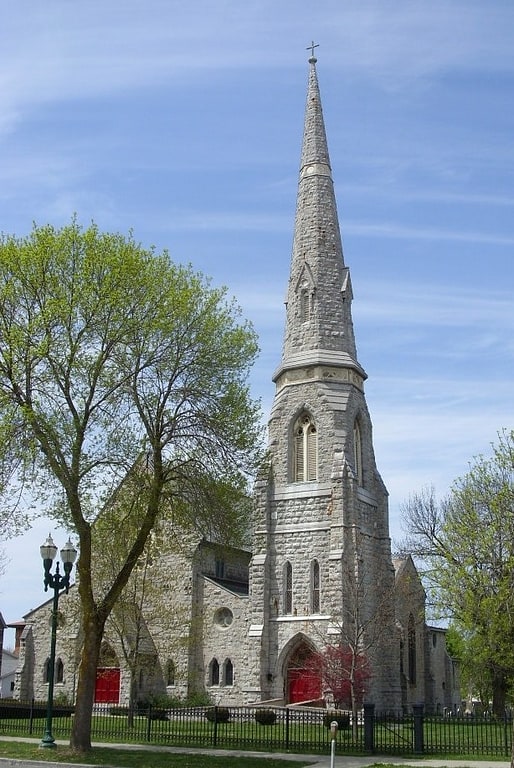
Church. The St. Peter's Episcopal Church Complex is a historic Episcopal church complex located at 169 Genesee Street in Auburn. The complex consists of the church, the Parish House, a cemetery, and a small burial plot.
The church as built in 1868–1870 was designed by architect Henry Dudley in the Gothic Revival style. It is constructed of rock faced limestone laid in random ashlar and trimmed with dressed limestone. It is composed of a rectangular shaped nave, flanked by side aisles and intersected by a compact transept, with an offset bell tower and spire highlighting an asymmetrically arranged facade. A large rose window is centered within the gable field of the nave.
The Parish House is a 2+1⁄2-story, H-shaped structure competed c.1930 and designed by William J. Beardsley in the late Gothic Revival style. The earliest burials date to about 1812, when the first Church of St. Peter occupied this site. The burial plot includes the remains of Enos T. Throop (1784–1874), Governor of New York from 1829 to 1833.
The parish is now known as the Saints Peter and John Episcopal Church.
It was listed on the National Register of Historic Places in 2002.[6]
Address: 169 Genesee St, Auburn
Schines Auburn Theatre
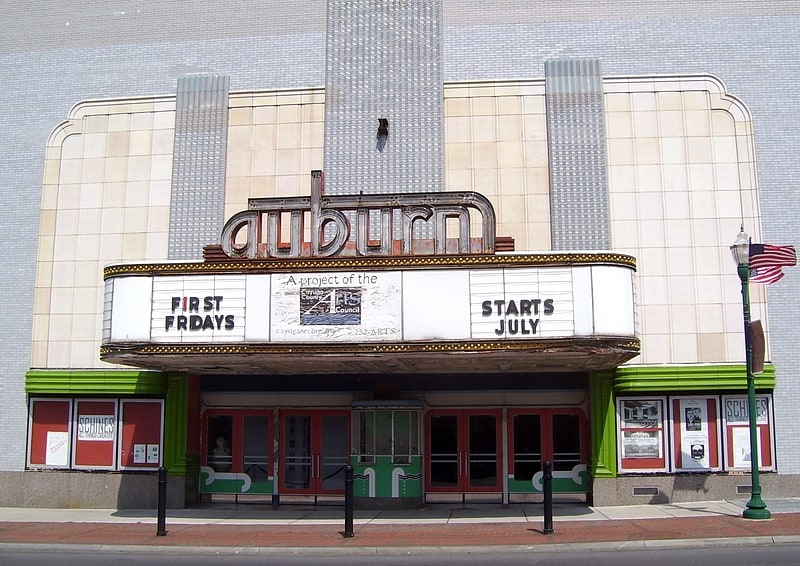
Schines Auburn Theatre is a historic theatre building located at 12-14 South Street between Genesee and Lincoln Streets in Auburn, New York. It is owned by the Cayuga County Arts Council. It is an outstanding example of the later Art Deco style of architecture in the Streamline Moderne vein designed by the noted theatre architect John Eberson. It was completed in 1938 and features a ceramic brick and terra cotta facade, a stylized marquee, and a 2,000 seat auditorium with a complex arrangement of flat and curvilinear wall and ceiling surfaces and reveals and decorated with a shooting star motif.
The Schines Theatre operation had two other theatres in Auburn, the Jefferson and the Palace, but the Auburn Theatre was the only one built specifically for the chain. The theatre was air conditioned using the latest available equipment, and it offered hard-of-hearing customers special headphones to better hear the films.
The theatre has been undergoing renovation since 2003, and the project was not complete as of 2012. It was listed on the National Register of Historic Places in 2000.[7]
Seymour Library

The Case Memorial-Seymour Library is a historic library building located at 176 Genesee Street in Auburn. It was built in 1898 and as designed by architects Carrère and Hastings, in the Beaux-Arts style. It is a square, two story, three bay building constructed of Flemish bond brick and limestone topped by a hipped roof. It opened in 1903 and was expanded in 1972.
The building was listed on the National Register of Historic Places in 1980.[8]
Address: 176-178 Genesee St, Auburn
Wall Street Methodist Episcopal Church
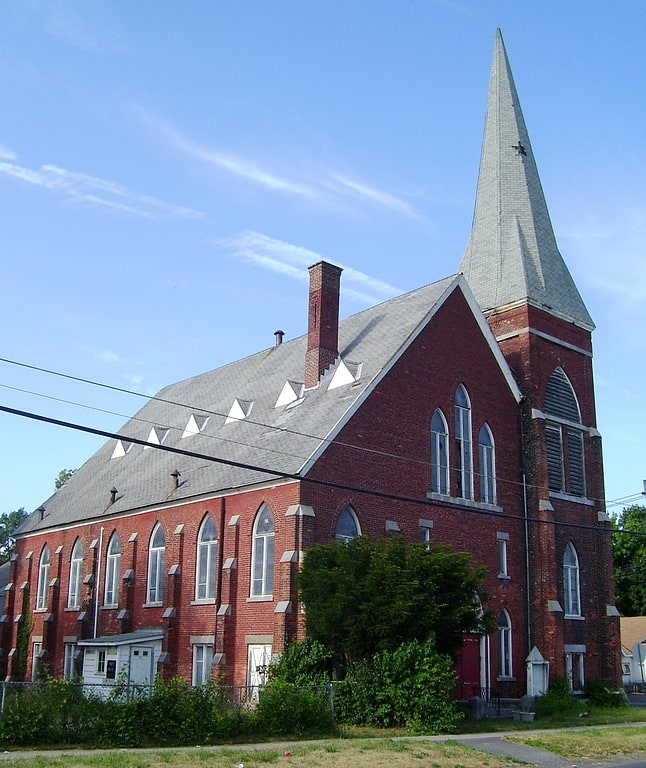
Church in Auburn, New York. Wall Street Methodist Episcopal Church, formerly the home of the African Methodist Episcopal Zion Church, was a historic Methodist Episcopal church located at 69 Wall Street in Auburn, New York, United States. It was a large Gothic Revival style brick and limestone structure built in 1788, and renovated in the 1887. Following years of neglect, it was damaged in a windstorm in the summer of 2021 and demolished. The facade was dominated by a square tower topped by a broach spire. It was an example of an auditorium plan church, popular in church design from the 1880s to 1920s.
The church was listed on the National Register of Historic Places in 1999.[9]
Harriet Tubman Grave
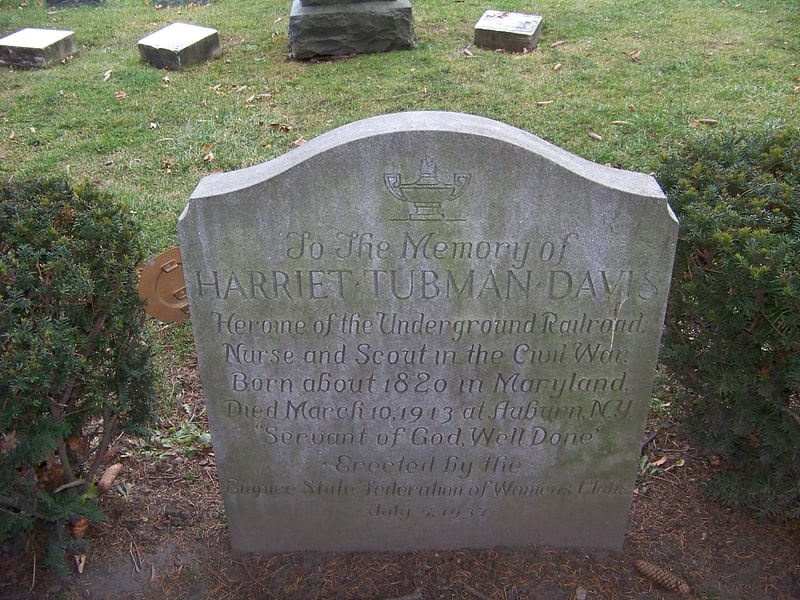
Harriet Tubman Grave is an historic gravesite located in Fort Hill Cemetery at Auburn, in Cayuga County, New York. The granite gravestone marks the resting place of famed African-American abolitionist and Christian Harriet Tubman, who was born into slavery in Maryland in the United States in 1822.
The gravestone marker is approximately three feet tall, and was erected in 1937 by the Empire State Federation of Women's Clubs. It is carved with the name "Harriet Tubman Davis (1820–1913)" on the front. On the back is an inscription commemorating Tubman's work with the Underground Railroad and her role as scout and nurse during the Civil War. The religious faith that marked all her activities is noted with the inscription "Servant of God, Well Done." The gravesite is located on Fort Hill Cemetery's "West Lawn C", beneath a large tree, with two small bushes on each side of her headstone.
Harriet Tubman's grave is the focus of an annual pilgrimage by the Thompson AME Zion Church to commemorate her life and work.
The gravesite was listed on the National Register of Historic Places in 1999.[10]
Ward W. O'Hara Agricultural Museum
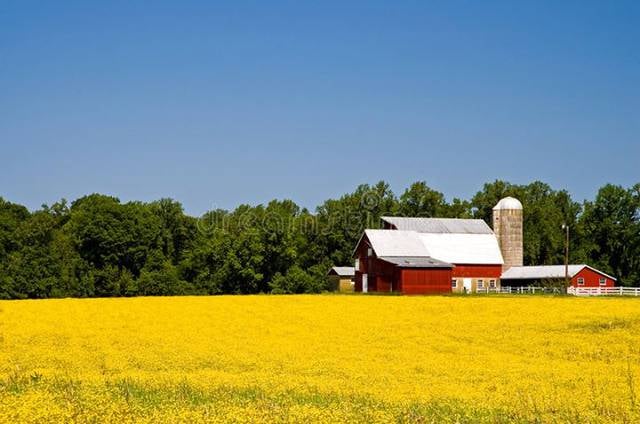
Museum, Specialty museum
Address: 6880 East Lake Road, 13021 Auburn